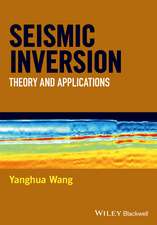The Last Deglaciation: Absolute and Radiocarbon Chronologies: Nato ASI Subseries I:, cartea 2
Editat de Edouard Bard, Wallace S. Broeckeren Limba Engleză Paperback – 24 feb 2012
Din seria Nato ASI Subseries I:
- 15%
 Preț: 641.85 lei
Preț: 641.85 lei - 15%
 Preț: 649.87 lei
Preț: 649.87 lei - 15%
 Preț: 659.70 lei
Preț: 659.70 lei - 18%
 Preț: 957.75 lei
Preț: 957.75 lei - 18%
 Preț: 941.05 lei
Preț: 941.05 lei - 18%
 Preț: 959.36 lei
Preț: 959.36 lei - 15%
 Preț: 664.93 lei
Preț: 664.93 lei - 15%
 Preț: 655.27 lei
Preț: 655.27 lei - 15%
 Preț: 644.49 lei
Preț: 644.49 lei - 15%
 Preț: 639.08 lei
Preț: 639.08 lei - 18%
 Preț: 952.57 lei
Preț: 952.57 lei - 15%
 Preț: 653.33 lei
Preț: 653.33 lei - 18%
 Preț: 958.56 lei
Preț: 958.56 lei - 15%
 Preț: 641.85 lei
Preț: 641.85 lei - 15%
 Preț: 650.86 lei
Preț: 650.86 lei - 18%
 Preț: 957.94 lei
Preț: 957.94 lei - 15%
 Preț: 649.54 lei
Preț: 649.54 lei - 15%
 Preț: 646.30 lei
Preț: 646.30 lei - 15%
 Preț: 648.89 lei
Preț: 648.89 lei - 15%
 Preț: 640.06 lei
Preț: 640.06 lei - 18%
 Preț: 950.21 lei
Preț: 950.21 lei - 15%
 Preț: 643.65 lei
Preț: 643.65 lei - 15%
 Preț: 649.54 lei
Preț: 649.54 lei - 15%
 Preț: 649.54 lei
Preț: 649.54 lei - 15%
 Preț: 641.71 lei
Preț: 641.71 lei - 15%
 Preț: 642.83 lei
Preț: 642.83 lei - 15%
 Preț: 639.59 lei
Preț: 639.59 lei - 15%
 Preț: 646.62 lei
Preț: 646.62 lei - 18%
 Preț: 962.49 lei
Preț: 962.49 lei - 15%
 Preț: 647.73 lei
Preț: 647.73 lei - 15%
 Preț: 641.71 lei
Preț: 641.71 lei - 18%
 Preț: 1231.47 lei
Preț: 1231.47 lei - 15%
 Preț: 649.22 lei
Preț: 649.22 lei - 15%
 Preț: 658.70 lei
Preț: 658.70 lei - 15%
 Preț: 641.71 lei
Preț: 641.71 lei - 15%
 Preț: 659.85 lei
Preț: 659.85 lei - 18%
 Preț: 1832.08 lei
Preț: 1832.08 lei - 18%
 Preț: 965.02 lei
Preț: 965.02 lei - 18%
 Preț: 955.25 lei
Preț: 955.25 lei - 18%
 Preț: 956.33 lei
Preț: 956.33 lei - 15%
 Preț: 650.55 lei
Preț: 650.55 lei - 18%
 Preț: 965.97 lei
Preț: 965.97 lei - 15%
 Preț: 652.64 lei
Preț: 652.64 lei - 15%
 Preț: 646.43 lei
Preț: 646.43 lei - 18%
 Preț: 1832.08 lei
Preț: 1832.08 lei - 18%
 Preț: 1225.62 lei
Preț: 1225.62 lei
Preț: 951.29 lei
Preț vechi: 1160.10 lei
-18% Nou
Puncte Express: 1427
Preț estimativ în valută:
182.02€ • 190.56$ • 150.62£
182.02€ • 190.56$ • 150.62£
Carte tipărită la comandă
Livrare economică 05-19 aprilie
Preluare comenzi: 021 569.72.76
Specificații
ISBN-13: 9783642760617
ISBN-10: 3642760619
Pagini: 364
Ilustrații: XIV, 344 p.
Dimensiuni: 170 x 242 x 19 mm
Greutate: 0.61 kg
Ediția:Softcover reprint of the original 1st ed. 1992
Editura: Springer Berlin, Heidelberg
Colecția Springer
Seria Nato ASI Subseries I:
Locul publicării:Berlin, Heidelberg, Germany
ISBN-10: 3642760619
Pagini: 364
Ilustrații: XIV, 344 p.
Dimensiuni: 170 x 242 x 19 mm
Greutate: 0.61 kg
Ediția:Softcover reprint of the original 1st ed. 1992
Editura: Springer Berlin, Heidelberg
Colecția Springer
Seria Nato ASI Subseries I:
Locul publicării:Berlin, Heidelberg, Germany
Public țintă
ResearchCuprins
I-Radiocarbon and Absolute Chronologies.- Tree-ring 14C calibration at 10.000 BP.- On flow model dating of stable isotope records from Greenland ice cores.- The clay-varve based Swedish time scale and its relation to the Late Weichselian radiocarbon chronology.- A step towards an absolute time-scale for the Late-Glacial: Annually laminated sediments from Soppensee (Switzerland).- The late Glacial-Holocene transition in central Europe derived from isotope studies of laminated sediments from Lake Go?cia? (Poland).- Younger Dryas oscillation — varve dated microstratigraphic, palynological and palaeomagnetic records from Lake Holzmaar, Germany.- 230Th/234U and 14C ages obtained by mass spectrometry on corals from Barbados (West Indies), Isabela (Galapagos) and Mururoa (French Polynesia).- II-Cosmonuclide Production Changes during the Past.- Expected secular variations in the global terrestrial production rate of radiocarbon.- 10Be deposition at Vostok, Antarctica, during the last 50,000 years and its relationship to possible cosmogenic production variations during this period.- 10Be peaks as time markers in polar ice cores.- Variation of geomagnetic field intensity from 8–60 Ky BP, Massif Central France.- A geomagnetic calibration of the radiocarbon time-scale.- III-Climatic Changes during the Last Deglaciation.- The strength of the nordic heat pump.- ?18O time-slice reconstruction of meltwater anomalies at Termination 1 in the North Atlantic between 50 and 80 °N.- A new method to reconstruct sea surface salinity: Application to the North Atlantic ocean during the Younger Dryas.- The determination of past ocean-atmosphere radiocarbon differences.- The last deglaciation in Antarctica: Further evidence of a “Younger Dryas” type climatic event.- Possible ice-coreevidence for a fresh melt water cap over the Atlantic ocean in the early Holocene.- Climatic changes in Northwest Africa during the last deglaciation (16–7 ka BP).- The palynological expression and timing of the Younger Dryas event — Europe versus Eastern North America.
















